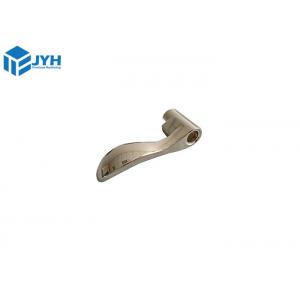Custom Die Casting Mould Service For Aluminum Alloys Of Complex
Conponents
What is the Die Casting service:
Die casting is a remarkable metal fabrication process that
harnesses the power of high-pressure molten metal to shape
intricate components. This technique relies on a pair of
meticulously machined, hardened tool steel dies, akin to precision
molds, which guide the metal into its final form. The materials of
choice are typically non-ferrous metals such as zinc, copper,
aluminum, magnesium, and various alloys.
For optimal results, hot- or cold-chamber machines are employed
based on the metal's characteristics. While die casting involves
significant initial investments in equipment and molds, it excels
in high-volume production. Its streamlined four-step process
ensures cost-effectiveness, making it ideal for crafting numerous
small- to medium-sized components.
As an ISO 9001:2015 certified company, we operate multiple
manufacturing facilities equipped with advanced technology to craft
top-notch components. With swift turnaround times, upon uploading a
design file, you can anticipate receiving a quote and DFM analysis
within just 12 hours.
Advantages of Die Casting Process
Die casting stands as a significant technique in metal fabrication,
esteemed for its cost-effectiveness and user-friendly nature.
The advantages it brings:
- Accomplish intricate part designs
- Reduce labor expenditures
- Attain varying wall thicknesses
- Achieve stricter tolerances
Disadvantages of Die Casting Process
- Incompatible with metals boasting elevated melting points
- Incompatible with extensive sheet metal components
- Extended lead times
Die Casting Alloys
Die casting commonly employs non-ferrous alloys prized for their
robust mechanical attributes. These non-ferrous components
contribute to the alloys' low melting points, which align with
their strong mechanical performance.Below, we list a few popular
alloy options:
Aluminum Alloys
|
| Aluminum alloys possess versatile qualities for various product
uses, with 380.0 being a popular die casting preference. Other
options like Alloys 360, 390, and 413 also exist, chosen based on
factors such as specific application requirements.
- Elevated operational temperatures
- Remarkable resistance to corrosion
- Lightweight nature
- Notable strength and hardness
- Favorable combination of stiffness and strength-to-weight ratio
|
Zinc Alloys
|
|
Zinc alloys offer remarkable strength, resilience, stability,
efficiency, and cost-effectiveness.
A variety of zinc alloys are available for utilization.
Nevertheless, the prevalent zinc materials for die casting include
Zamak #2, #3, #5, #7, ZA8, and ZA27, celebrated for the ensuing
qualities:
- Enhanced Castability
- Reduced Cycle Duration
- Prolonged Die Lifespan
|
Other Alloys
|
Die casting parts can also be crafted from alternative alloys such
as Bronze, Brass, lead, and tin.
Bronze, specifically white bronze, finds favor in the jewelry
sector for die casting. It boasts a color akin to white gold and
stainless steel alloys while remaining an ideal choice due to its
lower melting point.
|
Types Of Die Casting Processes
In the industrial realm, two main methods for die casting are the
hot chamber and cold chamber processes.
Below, we outline the details of these two processes.
Die Casting Process
Whether it's hot or cold chamber die casting, the standard
procedure involves injecting molten metal into a die mold using
high pressure. Here are the detailed steps in the die casting
process:
1. Clamping
At the outset, clean the die to eliminate impurities and apply
lubrication for smoother injection and product removal. Once
cleaned and lubricated, firmly close the die with high pressure.
2. Injection
Melt the chosen metal and pour it into the shot chamber. The method
differs based on the process being used. For example, the shot
chamber remains cold in cold chamber die casting but is hot in hot
chamber die casting. Following this, inject the metal into the die
using high pressure generated by a hydraulic system.
3. Cooling
While the die is closed, allow the metal to cool and solidify. The
resulting solid material will take on the shape of the mold design.
4. Ejection
After unclamping the die mold, an ejection mechanism will push the
solid casting out of the mold. Make sure the product has fully
solidified before ejecting.
5. Trimming
This marks the final step, involving the removal of excess metal
from the sprue and runner on the finished product. Trimming can be
done using a trim die, saw, or other methods. The removed metal
portions are recyclable and can be reused in the process.
Hot-chamber die casting
|
|
Hot-chamber die casting utilizes a molten metal reservoir to fill
intricate molds quickly, making it ideal for low-melting point
alloys like zinc and tin.
|
Cold Chamber Die Casting
|
|
Cold chamber die casting is excellent for handling high melting
point materials like aluminum, preventing damage to the pumping
system caused by extreme temperatures. In this method, molten
material is poured into a cold chamber before being injected into
the die, utilizing a hydraulic system similar to hot chamber
casting.
|
Surface Finish
Surface finishing is crucial in die casting to enhance product
aesthetics and functionality, ensuring parts meet
precise specifications and provide optimal performance.
| |
Powder Coating
| Ceramic Coating
|
| |
Anodizing
| Plating
|
Factors Influencing Die Casting Costs
Die casting is typically an economical manufacturing method, yet
costs can vary due to multiple considerations. Here are key aspects
to contemplate for optimal cost-effectiveness in your die casting
project:
The selection of materials significantly impacts die casting
expenses. Certain materials hold higher price tags, and the overall
cost of die casting materials tends to exhibit a general upward
trend, albeit with fluctuations.
Production costs hinge on three pivotal elements: tooling costs and
die casting expenses. Your chosen production processes,
technological strategies, mold fabrication procedures, and upkeep
efforts all interplay to influence tooling expenses, which can
potentially be substantial.
Mold costs are contingent upon the manufacturing approach employed.
For instance, employing CNC machining amplifies mold costs due to
the capabilities and benefits inherent to the method."
- Impact on Costs of Secondary Operations
Consider the expenses related to secondary operations, including
tasks like trimming, as they factor into the overall die casting
expenses. Thus, the scope, efficiency, and success of secondary
operation costs become significant considerations.
The cost of finishing is influenced by the chosen finishing
technique. For instance, processes like electroplating will incur
greater finishing expenses compared to painting.
FAQS
Die Casting:
The term "die casting" aptly describes the process, as it centers
around the use of specialized molds known as "dies." These dies are
meticulously crafted from durable steel through advanced techniques
like CNC machining. During the process, liquid metal is injected
into the die, taking its desired shape as it cools. The die is
composed of two halves: the fixed half, which remains stationary
and connected to the casting apparatus, and the ejector half, which
can move.
Sand Casting vs. Die Casting:
In the realm of metal fabrication, two prominent techniques stand
out: sand casting and die casting. The key distinction lies in the
composition of the molds employed. While die casting relies on
precisely crafted metal molds (dies), sand casting employs molds
made from sand. Additionally, die casting is most suitable for
non-ferrous metals with lower melting points, whereas sand casting
offers a broader spectrum of compatibility.
Injection Molding vs. Casting:
The mechanics of injection molding and casting bear a resemblance,
involving the injection of molten material into a mold that
subsequently cools to take shape. However, there's a pivotal
divergence. Injection molding specializes in plastics like ABS,
polypropylene, TPU, and polyethylene, crafting intricate plastic
parts. In contrast, die casting focuses on low-melting-point
metals, producing finely detailed metal components.
Shipping way:
Payment method:
After service:
Custom Die Casting Mould Service For Aluminum Alloys Of Shape
Conponents. We are your best partner!



